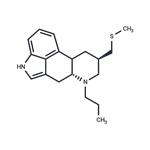dopamine receptor agonist, anti-Parkinson's agent
ChEBI: Pergolide is a diamine that is ergoline in which the beta-hydrogen at position 8 is replaced by a (methylthio)methyl group and the hydrogen attached to the piperidine nitrogen (position 6) is replaced by a propyl group. A dopamine D2 receptor agonist which also has D1 and D2 agonist properties, it is used as the mesylate salt in the management of Parkinson's disease, although it was withdrawn from the U.S. and Canadian markets in 2007 due to an increased risk of cardiac valve dysfunction. It has a role as an antiparkinson drug and a dopamine agonist. It is a diamine, an organic heterotetracyclic compound and a methyl sulfide. It is a conjugate base of a pergolide(1+).
Dimethyl disulfide (73.6 ml, 0.79 mol) and tri-n-butylphosphine (79.6 ml, 0.32 mol) were added to a solution of 9,10-dihydrolysergol in (8.1 g, 0.032 mol) in the 150 ml of anhydrous DMF and were stirred at room temperature for 6 hours under a nitrogen atmosphere. Dimethyl disulfide of the reaction mixture was removed under vacuo. A solution of the residue in ethyl acetate was extracted with 3.7% HCl (aq.). The aqueous layer was basified with ammonium hydroxide to a pH of 10 and then extracted with ethyl acetate. Removal of ethyl acetate followed by a silica gel column purification eluting with 10% MeOH/CH2Cl2 gave5.5.g of D-6-methyl-8β(methylthiomethyl)ergoline (60%).
A solution of D-6-methyl-8β-(methylthiomethyl)ergoline (0.4 g, 0.0014 mol) and NaI (0.63 g, 0.0042 mol) in 10 ml of propionic anhydride was refluxed for 40 hours. The reaction mixture was guenched with a 10% Na2CO3 solution and extracted by ethyl acetate. The combined organic layers were washed with a saturated brine solution, dried with magnesium sulfate and concentrated to produce oil. The oil was purified by silica gel column, eluting with 10% MeOH/CH2Cl2 to give 0.33 g of D-1,6-dipropionyl-8β(methylthiomethyl)ergoline.
LiAlH4 (0.6 g, 0.0156 mol) was slowly added to a solution of D-1,6dipropionyl-8β-(methylthiomethyl)ergoline in the 20 ml anhydrous THF at 0°C under nitrogene atmosphere. The mixture was stirred at 0°C for 30 min and then at room temperature for 4 hours. The reaction was cooled to 0°C and 0.6 ml of water was slowly added. The mixture was stirred at 0°C for 10 min and 1.8 ml of 15% NaOH (aq.) and 2.5 ml of water were added respectively. The mixture was stirred for 30 min at room temperature and then filtered. Excess of the solvent was removed under reduced pressure to give 150 mg of 8β-((methylthio)methyl)-6-propyl-ergoline or pergolide (yield: 68%). Ergoline,8-((methylthio)methyl)-6-propyl-, monomethanesulfonate, (8β)- may be prepared by mixing of components in solution.
Pergolide is a nonpeptide ergot derivative with higher potency and efficacy as a D1
agonist and equivalent D2 agonist activity when compared to bromocriptine. For Parkinson's
disease, as well as for inhibition of lactation, pergolide is more potent than bromocriptine and
may be effective in patients who have become tolerant to bromocriptine. After oral administration,
pergolide undergoes hepatic metabolism to 10 metabolites, some of which are pharmacologically
active. Elimination of the drug is primarily renal, with a half-life is approximately 27 hours.
Veterinary Drugs and Treatments
The primary use for pergolide in veterinary medicine is in treatment
of horses for pituitary pars intermedia dysfunction (PPID),
commonly called equine Cushing’s disease.
Extensively hepatically metabolised. At least 10
metabolites have been detected in the urine and faeces.
Following oral administration of [14C]-radiolabelled
pergolide mesilate to healthy subjects, approximately
55% of the administered radioactivity can be recovered as
pergolide metabolites from the urine, 40% from the faeces
and 5% from expired CO2
, suggesting that a significant
fraction is absorbed.



